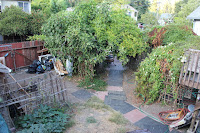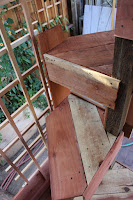I’ve
arrived at the mid-point, I guess. Basic
construction is complete, but many of the finer details I will address this
winter. This construction is a cat
staircase, nothing more nor less.
The
design of the spiral staircase blends well with the raised garden cabinets used
for vines in my backyard area. There are
three stair step levels, and then three landings – two for the cat and the
highest one is my bedroom/breakfast balcony floor.
That
first jump is over 2-1/2 feet and the next almost two feet as well. Big jumps, even for a cat, but I can always
add a small platform. These platforms
are made of soft redwood fencing boards.
Their texture is rough and uneven, perfect for cat-scratching and
clawing; also good for helping the climb up the staircase. There is a flower bed planter box along side
the stairs, with a trellis going up one side.
For
the cat, step two provides a view of the narrow passage between my house and my
neighbor’s. There’s the cover of the
trellis vine to watch the bird feeders along the fence line.
Or,
saying goodbye to the neighbor’s house, the cat can jump to level three, which
affords the initial view of y backyard.
This is a nice resting spot after having done three big jumps. A backward reflection on what a climb we have
made is shown next, looking down, which people say we should never do. Nonetheless, it provides perspective.
The
steps are necessary in their own right.
It’s not just to get to the landing decks for wonderful cat views of the
world. I’ve always hated cat doors
(others come in unwanted). An I won’t
put up with lengthy, midnight arguments about nocturnal freedom. So, my solution is the deck off my bedroom,
which has French doors that I leave open 99% of the time.
If
the raccoons can make it to my bedroom deck, then cats can do so as well. But I’ve made it easier for them with the
stairs, and a lot more pleasant with the two special lounging cat decks/landings. You can see on the left that the Sun Deck
will be a bright and spacious area for enjoying the backyard vista.
 Of
course, the best view is from the Observation Deck, one more landing up. It isn’t as roomy as the Sun Deck, which also
has rain protection. Even though
cramped, I already know that Peppermint Pattie, the cat in question, loves the
views from each of my highest windows: back yard, side yard, and front.
Of
course, the best view is from the Observation Deck, one more landing up. It isn’t as roomy as the Sun Deck, which also
has rain protection. Even though
cramped, I already know that Peppermint Pattie, the cat in question, loves the
views from each of my highest windows: back yard, side yard, and front.  She
is currently awaiting a surgery (of a private nature), and when the healing
from that is done [Halloween ?], we will have a grand opening.
She
is currently awaiting a surgery (of a private nature), and when the healing
from that is done [Halloween ?], we will have a grand opening.
2-legged
friends are restricted to the very top deck, which is my bedroom balcony.
This
construction work has been labelled, “Peter’s Folly”. Not just because it’s for a 6-month old
kitten, but also because the whims of all cats are capricious. It may never be used, but that is the prime
characteristic of “Folly’s”. The second
reason for the “Folly” nomenclature is that while photographing the
“contraption” from my normal deck, I was loathe to notice that that there was
only a two-foot difference in height between the two decks, across a span of a
dozen feet. I could have laid a 1” X 12”
twelve-foot board across the span, which would have allowed the cat to quite
happily use the back porch steps and then cross the gulch on the pine board
bridge, suitably outfitted with guard rails.








